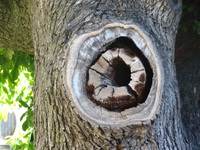Items
Site
The Medicine Chest
keywords is exactly
invasive
-

Lacuna (Part one)
"It is interesting to note that the botanical origins of most of these medicines were from outside of Africa, especially if one considers the long history of the Cape as a point on the trade routes where ill sailors regularly disembarked and drew on the knowledge of the Khoekhoe traditional healers for treatment and herbal cures (Laidler & Gelfand 1971: 44). The Cape flora offered a plenitude of medicinal resources and these healers (who were skilled in botany, surgery and medicine) used them in a variety of healing practices . The exclusion of local botanical remedies in the BWC No. 254 medicine chest can be attributed to many factors" (Liebenberg 2021: 67). -

Lacuna (Part two)
An ill English Oak on Hiddingh Campus, Michaelis School of Fine Art, University of Cape Town. English oaks were first brought into the country by the early settlers and were one of the first exotic tree species to be planted in South Africa, shortly after Van Riebeek’s arrival in 1652. He explained that in South Africa, these trees do not grow as old as they would have in Europe. The high temperatures cause these trees to grow faster than their species back home, and because of this, their centers start rotting over an extended period of time. The center part of the wood – the heart – is affected by this occurrence and hollowed out over time. -

Dis-Location/Re-Location
Farber's research examines themes of adaptation to new surroundings and circumstances through the real-life persona of Bertha Guttmann, a Jewish woman brought to South Africa from Sheffield in 1885 at the age of 22. She entered into an arranged marriage with Sammy Marks, who rose from being a peddler to one of the old Transvaal Republic’s leading industrialists. They lived in a beautiful home, now a museum, called Zwartkoppies, east of Pretoria. "Rather, from the initial cut, she inserts a seedling aloe into her flesh, delicately ‘planting’ the indigenous South African succulent into her forearm. This action represents a physical grafting of an alien botanical life form into the “lily-white corpus of Europe” (Ord 2008:106)" (Farber 2012: 35). Bertha Marks’s construction of the formal English rose garden on the ‘moral wastes’ of the Highveld could be recognised as part of a broader colonial project to ‘civilise’ the ‘barbaric’ African land. The road leading to the eastern gate of Zwartkoppies is lined with Eucalyptus trees planted by Sammy Marks. Rather as in his wife’s attempt to create her formal rose garden in her new surroundings and in so doing to ‘tame’ nature, Sammy Marks embarked on an ambitious campaign to “reclaim” and “green” Zwartkoppies, “creating a civilised landscape out of what his secretary called a wilderness” (Mendelsohn 1991:104). Thousands of trees were planted, mainly exotic varieties such as pines and blue gums, as well as orchards and vineyards (Mendelsohn 1991:104)" (Farber 2012: 58) -

Seeds of Change
"'Seeds of Change' is an ongoing investigation based on original research of ballast flora in the port cities of Europe. Projects have been developed for Marseilles, Reposaari, Dunkirk, Exeter and Topsham, Liverpool and Bristol. Material such as stones, earth, sand, wood, bricks and whatever else was economically expedient was used as ballast to stabilize merchant sailing ships according to the weight of the cargo. Upon arrival in port, the ballast was unloaded, carrying with it seeds native to the area where it had been collected. The source of these seeds can be any of the ports and regions (and their regional trading partners) involved in trade with Europe. The botanist, Dr. Heli Jutila, an expert on ballast flora writes, 'Although seeds seem to be dead, they are in fact alive and can remain vital in soil for decades, and even hundreds of years in a state of dormancy'. Seeds contained in ballast soil may germinate and grow, potentially bearing witness to a far more complex narrative of world history than is usually presented by orthodox accounts" (Alves 2021).


